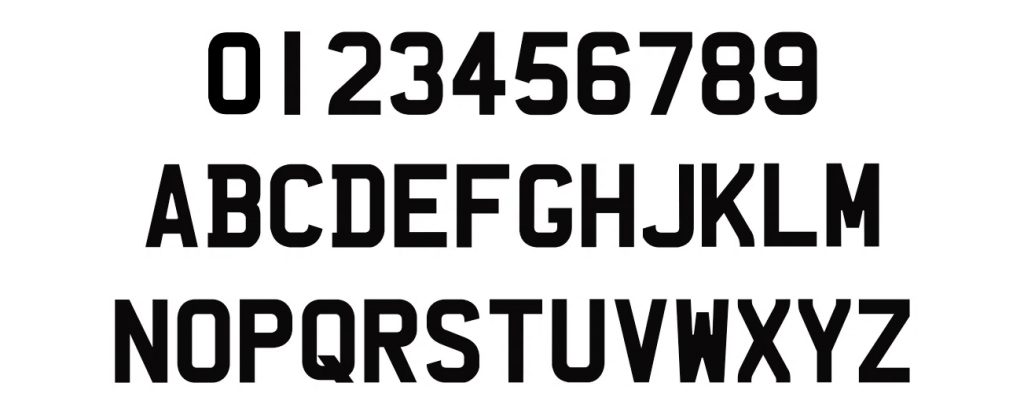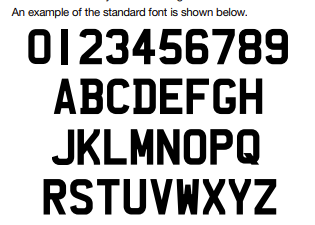
Number Plate Fonts – Rules and Regulations
What font is used on UK number plates?
‘Charles Wright’ has become the industry standard font in the UK, making it synonymous with the government’s ‘prescribed font’.
The ‘Prescribed Font’
Despite this, no single font is specifically named in the UK government’s legislation document entitled The Road Vehicles (Display of Registration Marks) Regulations 2001. This is also the case with the DVLA, as no font is specified in the their INF104 (Vehicle registration numbers and number plates) document.
However, the 2001 legislation does provide example characters which are collectively referred to as the ‘prescribed font’.
Therefore, it is stated that vehicle registrations ‘must either be in the prescribed font or in a style which is substantially similar to the prescribed font so that the character is easily distinguishable’.
What about the Charles Wright font?
Software for number plate manufacturing typically arrives with a font called ‘Charles Wright’ pre-loaded.
As a result, ‘Charles Wright’ has become the industry standard in the UK, making it synonymous with the government’s ‘prescribed font’.
However, whilst the majority of plate makers use a variation of ‘Charles Wright’, you will occasionally see some plates using alternative fonts.
Rules for number plate fonts
“Each of the characters of the registration mark must either be in the prescribed font or in a style which is substantially similar to the prescribed font so that the character is easily distinguishable…”.

Additionally, characters on all number plates (except motorcycles and tricycles) need to be a certain height and size:
- characters must be 79mm tall
- characters (except the number 1 or letter I) must be 50mm wide
- the character stroke (the thickness of the black print) must be 14mm
- the space between characters must be 11mm
- the space between the age identifier and the random letters must be 33mm
- the margins at the top, bottom and side of the plate must be 11mm
- vertical space between the age identifier and the random letters must be 19mm
Are there differences between the Prescribed Font and Charles Wright?
There are subtle differences between the characters in the legislation’s ‘Prescribed Font’ and the commonly used ‘Charles Wright’
However, there is one major difference between the two.
As demonstrated by the image, the middle strokes of the W and M characters differ where their points converge.

Confusingly, the DVLA has used both styles in two iterations of their INF104 document. The document produced in 2014 shows the ‘Prescribed Font’ with the thicker middle stroke, whereas the 2022 variant displays the ‘Charles Wright’ point.
The issue with the sharper point, however, is that it doesn’t conform to the rules laid out in The Road Vehicles (Display of Registration Marks) Regulations 2001.
- “The character stroke (the thickness of the black print) must be 14mm.”
With the ‘Charles Wright’ typeface, the converging point of its W’s and M’s can never meet a 14 mm thickness.
This is one of the main issues with number plates on the road today, yet it seemingly goes unnoticed.
Therefore, although the likes of the DVLA have used ‘Charles Wright’ in their official documentation, the font character style isn’t technically legal.
However, if you do have the pointier version of a ‘W’ or an ‘M’ on your plate, there probably isn’t a lot to worry about – this area of the law appears relatively unknown.
Sources
- Legislation – The Road Vehicles (Display of Registration Marks) Regulations 2001: https://www.legislation.gov.uk/uksi/2001/561/introduction
- DVLA – INF104 (Vehicle registration numbers and number plates) [2022]: https://assets.publishing.service.gov.uk/media/62554c78d3bf7f600782fd4f/inf104-vehicle-registration-numbers-and-number-plates.pdf
- DVLA – INF104 (Vehicle registration numbers and number plates) [2014]: https://assets.publishing.service.gov.uk/government/uploads/system/uploads/attachment_data/file/359317/INF104_160914.pdf
- British Number Plate Manufacturers Association: https://www.bnma.org/advice-centre/number-plate-design/legal-fonts/?activated=true#jumpto
- DVLA – V796: https://assets.publishing.service.gov.uk/media/5a758474e5274a1622e22662/V796.pdf

